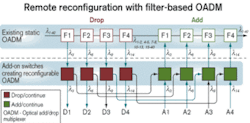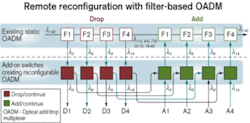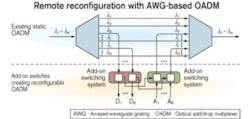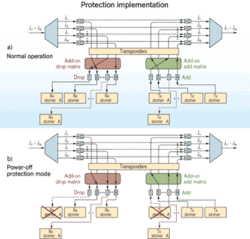Reconfigurability ROADMap: Extending static OADM
The majority of optical-add/drop-multiplexer (OADM) systems deployed in metro DWDM networks today are static. Channels are extracted or added through the use of wavelength-selective components, while the rest of the wavelengths or DWDM channels pass through the system unaffected. Once these systems are deployed, the channel scheme is fixed. Any subsequent changes require the manual removal or addition of inline filters, which results in traffic disruption during reconfiguration. Done manually, service provisioning is slow, costly, and prone to errors and periodic traffic disruptions.
To offer new services and cut operational expenditures, carriers require the higher degree of flexibility provided by reconfigurable optical add/drop multiplexers (ROADMs), which enable carriers to provision or "tune" individual wavelengths on the fly without network disruption. The transition from fixed OADMs to these new systems must be done gradually, capping new expenditures, protecting investments, and minimizing network downtime during the upgrade period. A cost- and time-effective means of upgrading legacy networks can be achieved by extending static OADM functionality through the use of add-on optical-switching systems.
Static OADMs can support remote reconfigurability through the use of add-on selector switches that allow operators to program individual wavelengths. These optical switches enable the carrier to select whether a wavelength, which is extracted through the fixed filter, is dropped to a local user, or carried through. The add-on selector switches provide the same reconfiguration features for the "add" channels. For example, in Figure 1, channels 3, 6, and 14 are dropped, and subsequently new traffic is added on these channels, while channel 9 is carried through. By remotely managing the optical-switching system, operators can reconfigure the system at a later date, dropping or adding channel 9 and carrying channel 14 in a pass-through configuration.Add-on optical-switching systems are designed to carry traffic through a default configuration during power failure. Using this feature, operators can interconnect their network links such that traffic is carried through during power failure, bypassing the failed site. With a similar implementation to the one shown in Figure 1, critical traffic destined for the failed site can be processed at another fallback site. Alternatively, the signals can be blocked to avoid interference in the network if there are no free or backup drop ports at other sites.
Optical planar-lightwave-circuit (PLC) technology is particularly suitable as the basis for add-on optical-switching systems because it is a solid-state technology. With no moving parts, PLC switching systems are highly reliable, making them well suited for carrier-grade availability requirements.
PLC switches use waveguides rather than free-space optics and therefore can manipulate optical signals—multicasting and attenuating them. Intelligent PLC-based switching systems use multicasting to support drop and continue OADM configurations. Using two sets of selector switches, DWDM channels can be dropped at one site and carried downlink to other sites. This feature is useful in the implementation of optical virtual private networks, video distribution, and the construction of resilient inter-ring links.
By using add-on switching systems that feature integrated variable-optical-attenuator (VOA) functionality, along with the associated control plane, operators can dynamically control the power levels of the added channels. Control of the power levels is highly useful in networks that employ EDFAs.
There are other methods for deploying filter-based OADMs, all of which can be upgraded to support remote configuration through the use of add-on optical-switching systems. Similarly, static OADM systems, deployed within dual-counter rotating rings can be upgraded using the same principle. Protected channels are connected to the outside world through protection switches.In OADMs and simple ROADMs, the connection between the tributary and clients is fixed. Thus, the client's data is always transported on a fixed wavelength. This type of connectivity is inflexible and often requires manual reconnection. As shown in Figure 3, customer A is connected to tributary 1 and is therefore capable of receiving only services carried on λ1. Similarly, customer J is capable of connecting only to services carried on λN. To assign services from λ1 to customer B or from λi to customer A, these customers must be manually reconnected at the corresponding tributaries.
Dynamic reconfiguration, however, allows the mapping of any service to any customer. OADM systems can be upgraded to support dynamic reconfiguration through the use of add-on optical-switching systems, as shown in Figure 3 (top and bottom). A crossconnect matrix is used to route services to the appropriate customers.
Some customers, with stringent availability requirements, may use redundant equipment and tributaries for recovery of equipment (customer, tributaries, and even complete site) failure. The dynamic switching add-on systems can support these redundancy features. If spare tributaries are available, the customer's equipment is connected to two separate ports and connectivity is established to this equipment based on its protection needs (see Figure 4). During failure of the primary equipment, the switching systems are reconfigured to maintain connectivity to the customer's secondary equipment. In environments where no spare ports are available, carriers can provide protected services through the use of dedicated optical protection-switching systems.Through the use of dynamic configuration, multiple customers can time-share wavelength services. For example, customer A may use wavelength service λ1 during work hours, while customer E may use the same services during off-hours.
Extending static OADM-based networks with add-on optical-switching systems that support reconfiguration requires the integration of these systems into the network management or operational support system. Therefore, add-on switching systems must support standard management protocols such as simple network management protocol (SNMP).
Add-on optical switches can be used to upgrade legacy OADMs to dynamically reconfigurable OADMs, providing added functionality and investment protection. PLC-based switches address the two major considerations that drive market preferences—performance requirements and volume cost—making these systems a logical choice as metro carriers begin to upgrade their legacy networks to support dynamic reconfiguration. PLC-based add-on switching systems are not only uncommonly fast, but they are also impervious to future multifunction integration and offer unique features of multicasting that can address drop and continue and multidrop applications.
Dr. Narda Ben-Horin is account director, Guy Kronenthal is director of systems architecture and software, and Abe Queller is vice president of applications engineering at Lynx Photonic Networks (Rosh Ha'ayin, Israel, and Calabasas Hills, CA). The authors can be reached via e-mail at [email protected], [email protected], and [email protected].




